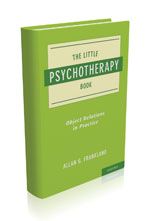Publication
Article
Psychiatric Times
The Little Psychotherapy Book: Object Relations in Practice
Author(s):
This book is recommended for therapy trainees who are interested in relational psychodynamic approaches and concerned with putting these seemingly abstract concepts into “real world” practice.
In The Little Psychotherapy Book: Object Relations in Practice, Dr Allan Frankland simplifies object-relational theory and offers concrete advice for the beginning clinician. Throughout the text, Dr Frankland successfully demysti-fies technical terms, such as “projective identification” and “object constancy,” in a way that is easily digestible for the new therapist-all without losing their depth and complexity. Particularly impressive are explanations of Klein’s paranoid-schizoid and depressive positions and his application of these abstract concepts to a realistic case example. His use of the same case throughout the book provides simplicity and continuity, and transcripts that illustrate the progression of the case over time are annotated with descriptions of the therapist’s use of techniques such as confrontation, clarification, and interpretation.
The book offers a nice balance of structure and flexibility in its didactic approach. For example, Dr Frankland developed 2 mnemonic acronyms to help guide the novice clinician (eg, psychiatric residents and doctoral students in clinical psychology) through their sessions with patients. The first concerns the therapist’s interventions: Hear, Observe, React, Synthesize, Execute (H.O.R.S.E.). The second focuses on the content of the client’s communication: Concrete, Others, Self, Therapist (C.O.S.T.). In so doing, the author simplifies what can of-ten seem a like a mystifying process. At the same time, Dr Frankland encourages his readers to develop their own style and clinical intuition and discourages dogmatism and rigidity.
The second half of the book reads like a trusted supervisor offering advice on basic clinical quandaries. For example, Dr Frankland makes recommendations on how to begin an initial session (including whether or not to speak before the patient does); self-disclosure; and how to handle gift giving and requests for advice from patients. His discussion of these topics is likely to be appreciated, since trainees often hesitate to ask their supervisors such questions, fearing they should already know how to handle difficult situations. On the other hand, more often than not, supervisors take for granted that their trainees must have learned about these issues “somewhere along the way” and rarely explicitly address them.
At times, Dr Frankland’s suggestions are drawn directly from object-relational theory; but more often, he seems to rely on his own clinical experience, ie, what has worked for him. Of course, the danger of offering such idiosyncratic solutions is that trainees may merely mimic Dr Frankland without a full understanding of the theoretical and clinical rationale underlying the intervention. For example, he could have spent more time discussing the “healing factors” in object-relational psychotherapy so that trainees could go beyond learning what to say and when to say it and develop a deeper appreciation for why these techniques work. Nonetheless, this book is recommended for therapy trainees who are interested in relational psychodynamic approaches and concerned with putting these seemingly abstract concepts into “real world” practice.







